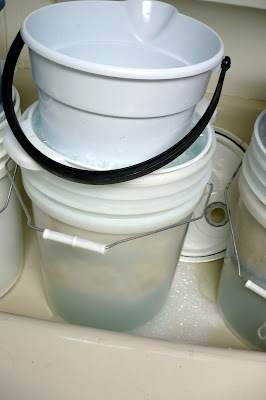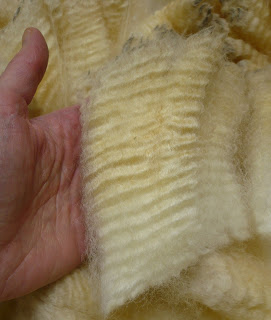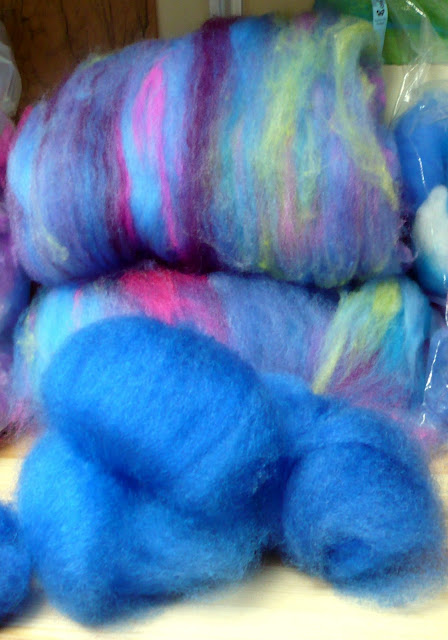
I was about to embark on a batt-a-thon when I was interrupted by a gloriously sunny day, one that demanded to be taken advantage of through the drying of a newly-washed fleece. Being only an in-between-time fibre artist -- having work, children, husband, household affairs, friends, family, and a recent fabric sale that led to extravagant purchases on my part accompanied by lavish promises of summer fashions for my daughter -- I have to grab my fleece-drying days as I can. If it means putting off other fibre-related fun, alas, so it must be. And don't get me wrong; I love washing fleece. I love transforming the richly-scented bags of wonderful that the perplexed postal carrier lugs up to my door into ready-to-use ooh-la-la. As it is shearing time, and as I have a few newly purchased raw fleeces I can't wait to dig into, it was easy to comply.
The chosen one was a beautiful 6.5-lb Corriedale from Rupperts.
 |
| No VM in this lovely covered fleece with amazing staple length. Some of the raw wool almost looked clean already, like maybe this was an indoor sheep or something. |
 |
| colander pushes the fleece below water-level |
 |
| bucket of water holds it there |
 |
| That's 6.5 lb of raw fleece soaking away |
I know, what's with the waist-high bathtub? The people who owned our house before us ran a dog-grooming business. This tub is perfect for washing fleece and yarn and making felt -- any kind of big wet job your sink can be too small for -- although first-time visitors tend to be taken aback on seeing the heavy chainlinks embedded in the walls at either end . . . really, it's not that hard to get my kids to have a bath! And don't worry; we do have a normal bathroom upstairs!
 |
| Raw, unwashed lock |
 |
| pure white, washed lock of Corriedale |
As you can see, the fleece cleaned beautifully and combed into the most marvellous top -- how could I resist using it immediately?!
Having washed another fleece and put the sunny, hot day to good use, it was time to get back to my blue batts. To that end, I combed and carded some of each of my blues above, plus some more blue fleece I had, and added a few colours I couldn't resist.
 |
| My crafting table, ready to start carding the batts - see my little white nest of Corriedale? |
This assortment includes Romney x Merino, Corriedale, Cotswold, Romney lamb, Cormo, Merino, Lincoln Longwool, Bluefaced Leicester x Corriedale, Bluefaced Leicester x Romney/Cotswold, Border Leicester x Bluefaced Leicester, Bluefaced Leicester cross (can't remember what it was crossed with...), representing sheep from Little Smoky Blues, Wooly Wool of the West, Aye Sea Ewe, MMF Wool, Aspen Grove Farm and Rupperts, mentioned above.
I carded them using the "sandwich" method as described here by Ashley Martineau of Neauveau Fiber Arts. I like the way this method randomly blends parts of the colours and leaves other parts standing alone.
I had enough wool for four batts, which would make two skeins of wool on my wheel. Two I wanted to use for a two-ply, teardrop-plied yarn, using the batts for one heavier ply, and some gorgeously lustrous BL/BFL for the other, which I would spin much thinner to create that nice teardrop ply. Here they are, tempting me to spin them:
 |
| Resistance, as they say, is futile |
Here's the single from the batt:
And the finished yarn:
 |
| A good 55 yards (51 m) long, and very bulky at 4 wpi. You can find it in my shop HERE |
First the long single from the batts:
 |
| You can see this is a lot thinner than the other one |
Supercoiled yarn is spun by coiling a single like the one above around a core yarn. Sometimes I use 8/4 cotton warp, but this time I used a wool-nylon mill-spun purple yarn. Wool hangs and handles differently than cotton, of course, so using a different core will allow you to manipulate the finished yarn a bit differently. I used wool for this skein because I felt like it (so often my reason for doing so many things...).
Here I am spinning it:
 |
| There's lots of extra twist in the singles so it holds together okay as a coil |
I like to measure off the yarn I need for the core ahead of time, wind it into a butterfly, and let it hang down as I spin. I know a spindle full of yarn is going to spin me about 25-30 metres of supercoiled yarn, so I measure it off approximately and if I run out I can always tie on more. With the butterfly dangling below, I can allow the extra twist that builds up in the core to unwind as I spin. Every so often I stop and let the unspinning dangling core catch up with me.
 |
| My dangling butterfly of inner core yarn, which I help untwist with my left hand as I'm spinning, and the kinky outer yarn angling in from the lazy Kate |
I do this because I really don't like the way supercoil yarn cores overtwist when I spin them. And even if I run the core yarn through the wheel in the opposite direction ahead of time to make up for the fact that I'm going to be adding twist to an already twisted yarn, it still overtwists, plus I'm now trying to manage two overtwisted yarns and the whole drama starts to drive me crazy.
Here's the finished yarn:
 |
| The colours came out more purplish than the other skein - it's about 36 yards/33 m long |
 |
| And here it is in my SHOP |





























